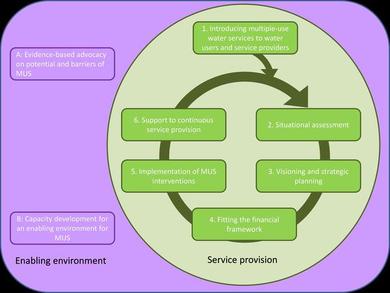The MUS Cycle
The MUS Cycle

In order to develop guidelines on how to plan for and provide multiple-use water services, a number of existing MUS guidelines were reviewed. We found that these guidelines use different project, management and service delivery cycles. However, they also share a number of common elements. In order to reach a generic framework for the purpose of these generic guidelines, the different cycles used in different existing guidelines were compared and common elements were identified.
In order to develop guidelines on how to plan for and provide multiple-use water services, a number of existing MUS guidelines were reviewed. We found that these guidelines use different project, management and service delivery cycles. However, they also share a number of common elements. In order to reach a generic framework for the purpose of these generic guidelines, the different cycles used in different existing guidelines were compared and common elements were identified.
A common element in all guidelines is the use of the project cycle, and within that, the emphasis on the earliest phases of that cycle. It is in these phases that MUS differs most clearly from conventional single-use water services approaches. Firstly, there is an awareness creation and, secondly, an assessment phase in one form or other, generally including an assessment of water demand, uses and water resources.
Thirdly, the assessment phase is generally followed by a planning phase. In several guidelines (Empowers guidelines, (Moriarty, et al., 2007); Danida guidelines for local IWRM (Van Koppen, 2006); MASSMUS (Renault, n.d.), the planning phase is preceded by a visioning phase. In these generic guidelines, the visioning phase is considered an essential part of the strategic planning phase and therefore these two are taken together.
Fourthly, although not explicitly defined or made explicit as a separate issue or phase in most of the existing guidelines, the MUS Group recognises that MUS interventions require a phase in which financial resources are matched with costs, which leads to the development and adoption of a financial framework for the development and provision of multiple-use water services. Obviously, the financial conditions strongly influence earlier phases as well, and later events may warrant going back to earlier phases. However, a clear phase of agreeing on matching costs and available resources, often through contracts, can be distinguished.
Fifthly, all guidelines include an implementation phase.Interventions to implement or improve multiple-use water services can include both construction of new, or rehabilitation of existing infrastructure, as well as interventions to improve governance though capacity development of service providers (like water users committees). Often these kinds of interventions will go hand in hand. This phase often includes the development of work- or action plans and is about the more pragmatic planning of concrete activities in order to achieve the vision.
Lastly, guidelines focussing on project cycles tend to have a monitoring and evaluation phase follow the implementation phase. However, for these guidelines, the focus is more on service provision with its on-going administration, management and O&M, including post construction support. For these guidelines, we consider the monitoring and evaluation to be part of the on-going administration during all phases, including management and O&M and post construction support to ensure continuous multiple-use water service provision.
So summing-up, the generic guidelines will consider the phases of the planning and provision of multiple-use water services as displayed in Figure 4.
This part of the guidelines presents the main objective, activities and tools that can be used for each phase of planning and provision of multiple-use water services. Part three focuses on the creation of the enabling environment for MUS.
Figure 4 -The MUS cycle

